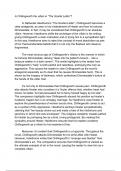Is Chillingworth the villain in “The Scarlet Letter”?
In Nathaniel Hawthorne’s “The Scarlet Letter”, Chillingworth becomes a
clear antagonist, as seen in his mistreatment of Hester and how he tortures
Dimmesdale. In fact, it may be considered that Chillingworth is an absolute
villain. However, Hawthorne shifts the archetype of the villain in his writing,
giving Chillingworth a clear motivation and or trying him in a sympathetic light.
In this way, Hawthorne aims to reject the concept of moral absolutism as part
of his Transcendentalist beliefs that it is not only the flawless who deserve
forgiveness.
The most obvious sign of Chillingworth’s villainy is the manner in which
he tortures Dimmesdale, delving “deep into his patient’s bosom… like a
treasure seeker in a dark cavern”. The simile highlights to the reader how
Chillingworth’s “help” is both painful and relentless, portraying the man as
aggressive. This causes the reader to view Chillingworth as the novel’s
antagonist especially as it’s clear that he causes Dimmesdale harm. This is
shown by the imagery of darkness, which symbolises Dimmesdale’s torture at
the hands of the older man.
It’s not only to Dimmesdale that Chillingworth causes pain. Chillingworth
also attacks Hester who considers it a “fouler offence that, whether heart had
known no better, he had persuaded her to fancy herself happy by his side”.
The comparison highlights how Chillingworth abused his position as Hester’s
husband, trappin her in an unhappy marriage. As Hawthorne uses Hester to
explore the powerlessness of women across time, Chillingworth comes to act
as a symbol of this oppression. Hawthorne portrays Hester sympathetically,
claiming that “her beauty shone out and made a halo of the misfortune and
ignominy in which she was enveloped”. The religious metaphor creates pathos
for Hester by portraying her as a kind, loving protagonist. By creating this
sympathy around Hester, Hawthorne ensures that his readers condemn
Chillingworth as a villain for his treatment of her.
Moreover, it’s evident that Chillingworth is a hypocrite. Throughout the
novel, Chillingworth attacks Dimmesdale for his sinful affair with Hester.
However, Hawthorne writes that Chillingworth’s “revenge was blacker” than
Dimmesdale’s sin. The comparative ensures that Chillingworth is viewed as
the ultimate example of sin in the novel, causing the reader to view him as a
complete villain.




